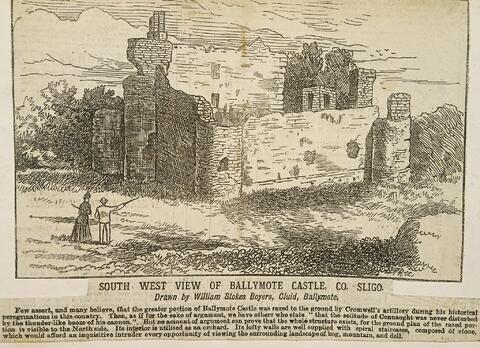Cote
Titre
Date(s)
- c.1895 (Création/Production)
Niveau de description
Étendue matérielle et support
1 p.; clipping
Nom du producteur
Histoire archivistique
Source immédiate d'acquisition ou de transfert
Portée et contenu
A clipping of an article on Ballymote Castle in County Sligo. The drawing is by William Stokes Boyers.
Évaluation, élimination et calendrier de conservation
Accroissements
Mode de classement
Conditions d'accès
Conditions de reproduction
Langue des documents
Écriture des documents
Notes de langue et graphie
Caractéristiques matérielle et contraintes techniques
Instruments de recherche
Existence et lieu de conservation des originaux
Existence et lieu de conservation des copies
Unités de description associées
Note
Built in the late twelfth century, the castle is an impressive Anglo-Norman fortification and one of the strongest fortresses of its era constructed in Connacht. It is believed to have been built by Richard de Burgh (c.1259-1326), 2nd Earl of Ulster, a friend of King Edward I (Edward Longshanks) of England, and one of the most powerful Norman lords of the period. As alluded to in the original caption, the castle has had a varied history of attack and destruction, changing hands several times between Gaelic clans and English forces.
It was from Ballymote that Aodh Ruadh Ó Domhnaill (Red Hugh O’Donnell) marched to the disastrous Battle of Kinsale in late 1601. It was subsequently surrendered to the victorious Crown forces under Charles Blount (Lord Mountjoy). In the seventeenth century, the castle was subjected to yet more military assaults and was finally abandoned in the 1690s. Over time, it fell into complete ruin. Ballymote Castle is now a designated national monument and is maintained by the Office of Public Works.

